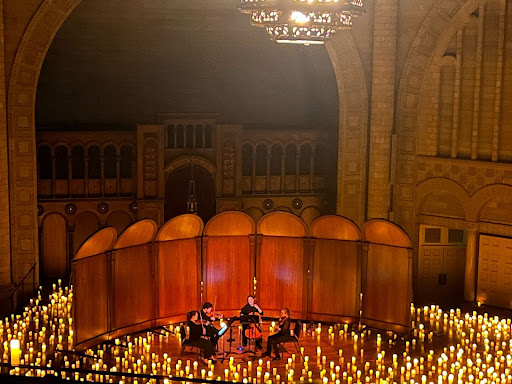“A Quiet Place” makes a big splash
May 1, 2018
In “A Quiet Place,” directed by John Krasinski, sound is equated with carnage. A seemingly innocuous creak may result in a gory attack. The film tells the story of a family of five, a mother, father, two sons and a deaf daughter, who become a family of four by the time the title flashes across the screen. They live in apocalyptic times where silence is vital and mistakes mean death. They must live as normal a life as possible, which is especially hard because the wife is pregnant and blind monsters have taken over, and, in the blink of an eye, decimate anything that creates an irregular sound. The family, Lee Abbott (John Krasinski), Evelyn Abbott (Emily Blunt), Marcus Abbott (Noah Jupe), Regan Abbott (Millicent Simmonds) and Beau Abbott (Cade Woodward), communicate with sign language to avoid making a sound.
The film’s concept is remarkably creative and is a refreshing break from ghosts, clowns and dolls that tend to dominate the horror film industry. I was forced to wonder if I was capable of living in the family’s reality, when the vast silence in the theater uncomfortably amplified the sound of every fidget of a movie-goer, crinkle of a candy wrapper and slurp of a soda. The poignant silence in the beginning of the film provided a sharp and effective contrast to sudden sound effects that cut through the air like a knife.
Because actors could not convey emotions through verbal words and cues, they had to rely solely on facial and physical expression. Scenes involving high-stakes interpersonal conflicts were especially impressive. Actors successfully emulated intense family arguments without uttering a sound. Of course, chemistry between actors was especially impressive, particularly between Krasinski and Blunt, real-life husband and wife.
Director John Krasinski expertly, yet discretely, foreshadowed primary plot shifts, especially in the beginning of the movie when setting up the family’s daily life in a horrifying world. A battery-operated toy or a protruding nail placed in an early scene served to escalate life-or-death conflicts that appeared later in the film.
The writers, director and production team of “A Quiet Place” worked well to make the film realistic within the confines of their fictional world. It made sense that the featured family were some of the last people to survive. They must have already learned sign language because their daughter was deaf, therefore, they were capable of communicating in silence. It made sense that they used felt markers for board games to reduce noise. It made sense that they laid sand over outdoor paths to muffle footsteps.
However, there were several large details that were overlooked. The family had electric lights outside, but where did the electricity come from? Do they have a generator that is somehow silent? Additionally, Krasinski’s character knows that when presented with two sounds, the monsters will only hear the louder sound, which he demonstrates to his son during a trip to a waterfall. This begs the question, why does the family not choose to permanently live near a waterfall, or, at the very least, live near a waterfall until the wife gives birth?
“A Quiet Place” featured incredible acting and unexpected twists. The chemistry between Krasinski and Blunt created realistic family dynamics, and the maturity of the young actors added depth. Despite minor plot holes, this thrillingly creative horror movie cannot be missed.











